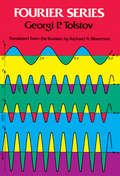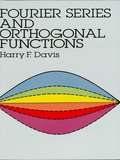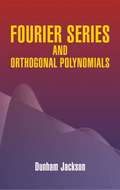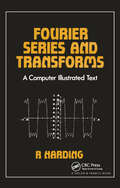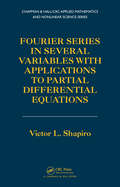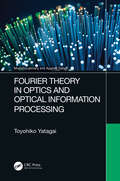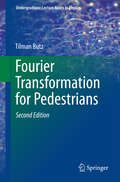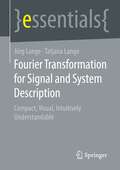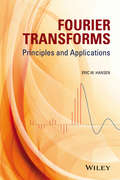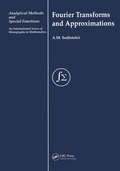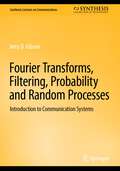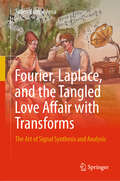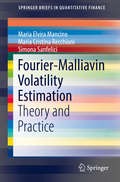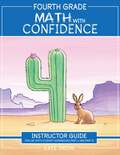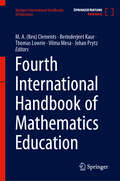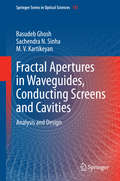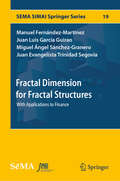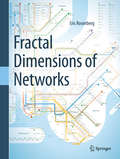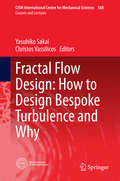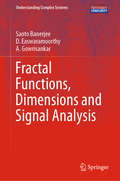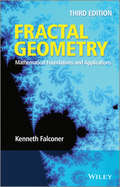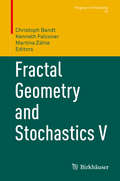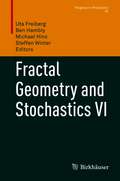- Table View
- List View
Fourier Restriction, Decoupling, and Applications (Cambridge Studies in Advanced Mathematics #184)
by Ciprian DemeterThe last fifteen years have seen a flurry of exciting developments in Fourier restriction theory, leading to significant new applications in diverse fields. This timely text brings the reader from the classical results to state-of-the-art advances in multilinear restriction theory, the Bourgain–Guth induction on scales and the polynomial method. Also discussed in the second part are decoupling for curved manifolds and a wide variety of applications in geometric analysis, PDEs (Strichartz estimates on tori, local smoothing for the wave equation) and number theory (exponential sum estimates and the proof of the Main Conjecture for Vinogradov's Mean Value Theorem). More than 100 exercises in the text help reinforce these important but often difficult ideas, making it suitable for graduate students as well as specialists. Written by an author at the forefront of the modern theory, this book will be of interest to everybody working in harmonic analysis.
Fourier Series
by Georgi P. TolstovRichard A. Silverman's series of translations of outstanding Russian textbooks and monographs is well-known to people in the fields of mathematics, physics, and engineering. The present book is another excellent text from this series, a valuable addition to the English-language literature on Fourier series.This edition is organized into nine well-defined chapters: Trigonometric Fourier Series, Orthogonal Systems, Convergence of Trigonometric Fourier Series, Trigonometric Series with Decreasing Coefficients, Operations on Fourier Series, Summation of Trigonometric Fourier Series, Double Fourier Series and the Fourier Integral, Bessel Functions and Fourier-Bessel Series, and the Eigenfunction Method and its Applications to Mathematical Physics. Every chapter moves clearly from topic to topic and theorem to theorem, with many theorem proofs given. A total of 107 problems will be found at the ends of the chapters, including many specially added to this English-language edition, and answers are given at the end of the text. Richard Silverman's excellent translation makes this book readily accessible to mathematicians and math students, as well as workers and students in the fields of physics and engineering. He has also added a bibliography, containing suggestions for collateral and supplementary reading. 1962 edition.
Fourier Series (Dover Books on Mathematics #1)
by G. H. Hardy W. W. RogosinskiGeared toward mathematicians already familiar with the elements of Lebesgue's theory of integration, this classic, graduate-level text begins with a brief introduction to some generalities about trigonometrical series. Discussions of the Fourier series in Hilbert space lead to an examination of further properties of trigonometrical Fourier series, concluding with a detailed look at the applications of previously outlined theorems. Ideally suited for both individual and classroom study.
Fourier Series and Orthogonal Functions (Dover Books on Mathematics)
by Harry F. DavisThis incisive text deftly combines both theory and practical example to introduce and explore Fourier series and orthogonal functions and applications of the Fourier method to the solution of boundary-value problems. Directed to advanced undergraduate and graduate students in mathematics as well as in physics and engineering, the book requires no prior knowledge of partial differential equations or advanced vector analysis. Students familiar with partial derivatives, multiple integrals, vectors, and elementary differential equations will find the text both accessible and challenging. The first three chapters of the book address linear spaces, orthogonal functions, and the Fourier series. Chapter 4 introduces Legendre polynomials and Bessel functions, and Chapter 5 takes up heat and temperature. The concluding Chapter 6 explores waves and vibrations and harmonic analysis. Several topics not usually found in undergraduate texts are included, among them summability theory, generalized functions, and spherical harmonics. Throughout the text are 570 exercises devised to encourage students to review what has been read and to apply the theory to specific problems. Those preparing for further study in functional analysis, abstract harmonic analysis, and quantum mechanics will find this book especially valuable for the rigorous preparation it provides. Professional engineers, physicists, and mathematicians seeking to extend their mathematical horizons will find it an invaluable reference as well.
Fourier Series and Orthogonal Polynomials: The Carus Mathematical Monographs, No. 6
by Dunham JacksonThis text for undergraduate and graduate students illustrates the fundamental simplicity of the properties of orthogonal functions and their developments in related series. Starting with a definition and explanation of the elements of Fourier series, the text follows with examinations of Legendre polynomials and Bessel functions. Boundary value problems consider Fourier series in conjunction with Laplace's equation in an infinite strip and in a rectangle, with a vibrating string, in three dimensions, in a sphere, and in other circumstances. An overview of Pearson frequency functions is followed by chapters on orthogonal, Jacobi, Hermite, and Laguerre polynomials, and the text concludes with a chapter on convergence. 1941 edition.
Fourier Series and Transforms
by R.D HardingThis book helps in giving a qualitative feel for the properties of Fourier series and Fourier transforms by using the illustrative powers of computer graphics. It is useful for wide variety of students as it focuses on qualitative aspects and the flexibility with regard to program modification.
Fourier Series in Several Variables with Applications to Partial Differential Equations
by Victor ShapiroDiscussing many results and studies from the literature, this work illustrates the value of Fourier series methods in solving difficult nonlinear PDEs. Using these methods, the author presents results for stationary Navier-Stokes equations, nonlinear reaction-diffusion systems, and quasilinear elliptic PDEs and resonance theory. He also establishes the connection between multiple Fourier series and number theory, presents the periodic Ca-theory of Calderon and Zygmund, and explores the extension of Fatou's famous work on antiderivatives and nontangential limits to higher dimensions. The importance of surface spherical harmonic functions is emphasized throughout.
Fourier Theory in Optics and Optical Information Processing (Multidisciplinary and Applied Optics)
by Toyohiko YatagaiFourier analysis is one of the most important concepts when you apply physical ideas to engineering issues. This book provides a comprehensive understanding of Fourier transform and spectral analysis in optics, image processing, and signal processing. Written by a world renowned author, this book looks to unify the readers understanding of principles of optics, information processing and measurement. This book describes optical imaging systems through a linear system theory. The book also provides an easy understanding of Fourier transform and system theory in optics. It also provides background of optical measurement and signal processing. Finally, the author also provides a systematic approach to learning many signal processing techniques in optics. The book is intended for researchers, industry professionals, and graduate level students in optics and information processing.
Fourier Transformation for Pedestrians
by Tilman ButzThis book is an introduction to Fourier Transformation with a focus on signal analysis, based on the first edition. It is well suited for undergraduate students in physics, mathematics, electronic engineering as well as for scientists in research and development. It gives illustrations and recommendations when using existing Fourier programs and thus helps to avoid frustrations. Moreover, it is entertaining and you will learn a lot unconsciously. Fourier series as well as continuous and discrete Fourier transformation are discussed with particular emphasis on window functions. Filter effects of digital data processing are illustrated. Two new chapters are devoted to modern applications. The first deals with data streams and fractional delays and the second with the back-projection of filtered projections in tomography. There are many figures and mostly easy to solve exercises with solutions.
Fourier Transformation for Signal and System Description: Compact, Visual, Intuitively Understandable (essentials)
by Tatjana Lange Jörg LangeThe authors explain the Fourier transform and its technical applications, especially in signal and system theory. Based on their many years of teaching experience, they aim at helping especially STEM (science, technology, engineering, and mathematics) students as well as graduated professionals to better understand the subject. The authors also point out the importance of a deeper understanding, as all modern digital technologies such as sound and image recording and storage, radio and television, mobile telephony, signal transmission for the Internet, modern control techniques for vehicles or aircrafts – are largely based on the Fourier transform. The Authors Prof. Dr.-Ing. habil. Jörg Lange held a leading position in the development area of mobile communications in a large technology company. Prof. Dr.-Ing. Tatjana Lange taught control systems engineering at Merseburg University of Applied Sciences and is still active in research in the area of classification and cluster analysis.This Springer essential is a translation of the original German 1st edition essentials, Fourier-Transformation zur Signal- und Systembeschreibung by Jörg Lange and Tatjana Lange, published by Springer Fachmedien Wiesbaden GmbH, part of Springer Nature in 2019. The translation was done with the help of artificial intelligence (machine translation by the service DeepL.com). A subsequent human revision was done primarily in terms of content, so that the book will read stylistically differently from a conventional translation. Springer Nature works continuously to further the development of tools for the production of books and on the related technologies to support the authors.
Fourier Transforms
by Eric W. HansenFourier Transforms: Principles and Applications explains transform methods and their applications to electrical systems from circuits, antennas, and signal processors--ably guiding readers from vector space concepts through the Discrete Fourier Transform (DFT), Fourier series, and Fourier transform to other related transform methods. Featuring chapter end summaries of key results, over two hundred examples and four hundred homework problems, and a Solutions Manual this book is perfect for graduate students in signal processing and communications as well as practicing engineers.
Fourier Transforms and Approximations (Analytical Methods and Special Functions)
by A M SedletskiiThree classes of Fourier transforms are presented: Fourier (Laplace) transforms on the halfline, Fourier transforms of measures with compact support and Fourier transforms of rapidly decreasing functions (on whole line). The focus is on the behaviour of Fourier transforms in the region of analyticity and the distribution of their zeros. Application
Fourier Transforms, Filtering, Probability and Random Processes: Introduction to Communication Systems (Synthesis Lectures on Communications)
by Jerry D. GibsonThis book provides backgrounds and the mathematical methods necessary to understand the basic transforms in signal processing and linear systems to prepare for in depth study of analog and digital communications systems.This tutorial presentation provides developments of Fourier series and other orthogonal series, including trigonometric and complex exponential Fourier series, least squares approximations and generalized Fourier series, and the spectral content of periodic signals. This text thoroughly covers Fourier transform pairs for continuous time signals, Fourier transform properties, and the magnitude and phase of Fourier transforms. The author includes discussions of techniques for the analysis of continuous time linear systems in the time and frequency domains with particular emphasis on the system transfer function, impulse response, system/filter bandwidth, power and energy calculations, and the time domain sampling theorem.
Fourier, Laplace, and the Tangled Love Affair with Transforms: The Art of Signal Synthesis and Analysis
by Sofen Kumar JenaUnlock the intricate language of signals and systems with this in-depth exploration of Fourier and Laplace transforms. Designed for advanced undergraduates, graduate students, and professionals in engineering, physics, and applied mathematics, this book unravels the foundations of signal processing with a rigorous yet engaging approach. Beginning with the fundamentals and building to advanced topics, each chapter guides you through the Fourier series, Fourier, and Laplace transform and into the realms of discrete Fourier and Z transforms, multi-dimensional analysis, and applications of the Fourier Transform in solving PDE, ODE, and Integral equations. The text brings mathematical theory to life through real-world applications in signal synthesis, systems engineering, and differential equations, making complex topics accessible and inspiring. With its unique blend of historical insights, practical applications, and intuitive explanations, this book offers a comprehensive yet approachable journey into the world of transforms. Whether you're a student building your foundation or a professional seeking to deepen your expertise, this book invites you to discover the elegance and utility of transforms in a way that bridges theory with the demands of modern engineering and science.
Fourier-Malliavin Volatility Estimation
by Maria Elvira Mancino Maria Cristina Recchioni Simona SanfeliciThis volume is a user-friendly presentation of the main theoretical properties of the Fourier-Malliavin volatility estimation, allowing the readers to experience the potential of the approach and its application in various financial settings. Readers are given examples and instruments to implement this methodology in various financial settings and applications of real-life data. A detailed bibliographic reference is included to permit an in-depth study.
Fourth Grade Math with Confidence Instructor Guide (Math with Confidence #0)
by Kate SnowTeach Fourth Grade Math with Confidence! This scripted, open-and-go program from math educator Kate Snow will give you the tools you need to teach math with confidence–even if you’ve never taught math before. Engaging, hands-on lessons will help your child develop a strong understanding of math, step by step. This scripted, open-and-go program from math educator Kate Snow will give you the tools you need to teach math with confidence–even if you’ve never taught math before. Engaging, hands-on lessons will help your child develop a strong understanding of math, step by step. · Multiplication with multi-digit numbers · Long division · Equivalent fractions · Adding and subtracting fractions and mixed numbers · Measuring angles · Multi-step word problems · Area, perimeter, and geometry · Decimals, measurement conversions, and graphs Your child will develop both strong math skills and a positive attitude toward math with fun activities like Mental Math Arcade, Fraction War, Race to 180°, and Decimal Least to Greatest. All you’ll need are this Instructor Guide, the two Student Workbooks (Part A and Part B), and simple household items (like play money, base-ten blocks, a protractor, and playing cards) to make math come alive for your child. Hands-on, incremental lessons that steadily build conceptual understanding Daily review to ensure children retain what they’ve learned and master essential skills Games and real-world activities make math fun Easy to use, with clear directions and explanatory notes Optional picture book recommendations and math enrichment activities
Fourth International Handbook of Mathematics Education (Springer International Handbooks of Education)
by M. A. Ken Clements Berinderjeet Kaur Thomas Lowrie Vilma Mesa Johan PrytzThis fourth international handbook discusses developments not recognized or dealt with fully in the first three Springer Mathematics Education handbooks and tackles controversial issues in the field. After starting with a provocative introductory chapter which asks whether controversy is a healthy feature of international mathematics education, the four following sections cover: (a) mathematics education in Asia; (b) the roles of theory in research and practice; (c) equity and social justice; and (d) curriculum and change. These themes are taken up in 28 chapters by 60 authoritative authors from all continents. Each of the four sections is structured on the basis of past, present, and future aspects. Like the first three mathematics education handbooks, this handbook provides a very valuable resource for teachers, mathematics education practitioners and researchers, education policy makers, and mathematicians, as well as graduate and undergraduate students.
Fractal Apertures in Waveguides, Conducting Screens and Cavities
by Basudeb Ghosh Sachendra N. Sinha M. V. KartikeyanThis book deals with the design and analysis of fractal apertures in waveguides, conducting screens and cavities using numerical electromagnetics and field-solvers. The aim is to obtain design solutions with improved accuracy for a wide range of applications. To achieve this goal, a few diverse problems are considered. The book is organized with adequate space dedicated for the design and analysis of fractal apertures in waveguides, conducting screens and cavities, microwave/millimeter wave applications followed by detailed case-study problems to infuse better insight and understanding of the subject. Finally, summaries and suggestions are given for future work. Fractal geometries were widely used in electromagnetics, specifically for antennas and frequency selective surfaces (FSS). The self-similarity of fractal geometry gives rise to a multiband response, whereas the space-filling nature of the fractal geometries makes it an efficient element in antenna and FSS unit cell miniaturization. Until now, no efforts were made to study the behavior of these fractal geometries for aperture coupling problems. The aperture coupling problem is an important boundary value problem in electromagnetics and used in waveguide filters and power dividers, slotted ground planes, frequency selective surfaces and metamaterials. The present book is intended to initiate a study of the characteristics of fractal apertures in waveguides, conducting screens and cavities. To perform a unified analysis of these entirely dissimilar problems, the "generalized network formulation of the aperture problems" by Mautz and Harrington was extended to multiple-aperture geometry. The authors consider the problem of coupling between two arbitrary regions coupled together via multiple apertures of arbitrary shape. MATLAB codes were developed for the problems and validated with the results available in the literature as well as through simulations on ANSOFT's HFSS.
Fractal Dimension for Fractal Structures: With Applications to Finance (SEMA SIMAI Springer Series #19)
by Manuel Fernández-Martínez Juan Luis García Guirao Miguel Ángel Sánchez-Granero Juan Evangelista Trinidad SegoviaThis book provides a generalised approach to fractal dimension theory from the standpoint of asymmetric topology by employing the concept of a fractal structure. The fractal dimension is the main invariant of a fractal set, and provides useful information regarding the irregularities it presents when examined at a suitable level of detail. New theoretical models for calculating the fractal dimension of any subset with respect to a fractal structure are posed to generalise both the Hausdorff and box-counting dimensions. Some specific results for self-similar sets are also proved. Unlike classical fractal dimensions, these new models can be used with empirical applications of fractal dimension including non-Euclidean contexts. In addition, the book applies these fractal dimensions to explore long-memory in financial markets. In particular, novel results linking both fractal dimension and the Hurst exponent are provided. As such, the book provides a number of algorithms for properly calculating the self-similarity exponent of a wide range of processes, including (fractional) Brownian motion and Lévy stable processes. The algorithms also make it possible to analyse long-memory in real stocks and international indexes.This book is addressed to those researchers interested in fractal geometry, self-similarity patterns, and computational applications involving fractal dimension and Hurst exponent.
Fractal Dimensions of Networks (Springerbriefs In Computer Science Ser.)
by Eric RosenbergCurrent interest in fractal dimensions of networks is the result of more than a century of previous research on dimensions. Fractal Dimensions of Networks ties the theory and methods for computing fractal dimensions of networks to the “classic” theory of dimensions of geometric objects.The goal of the book is to provide a unified treatment of fractal dimensions of sets and networks. Since almost all of the major concepts in fractal dimensions originated in the study of sets, the book achieves this goal by first clearly presenting, with an abundance of examples and illustrations, the theory and algorithms for sets, and then showing how the theory and algorithms have been applied to networks. Thus, the book presents the classical theory and algorithms for the box counting dimension for sets, and then presents the box counting dimension for networks. All the major fractal dimensions are studied, e.g., the correlation dimension, the information dimension, the Hausdorff dimension, the multifractal spectrum, as well as many lesser known dimensions. Algorithm descriptions are accompanied by worked examples, many applications of the methods are presented, and many exercises, ranging in difficulty from easy to research level, are included.
Fractal Flow Design: How to Design Bespoke Turbulence and Why
by Yasuhiko Sakai Christos VassilicosThis book focuses on turbulent flows generated and/or influenced by multiscale/fractal structures. It consists of six chapters which demonstrate, each one in its own way, how such structures and objects can be used to design bespoke turbulence for particular applications and also how they can be used for fundamental studies of turbulent flows.
Fractal Functions, Dimensions and Signal Analysis (Understanding Complex Systems)
by Santo Banerjee D. Easwaramoorthy A. GowrisankarThis book introduces the fractal interpolation functions (FIFs) in approximation theory to the readers and the concerned researchers in advanced level. FIFs can be used to precisely reconstruct the naturally occurring functions when compared with the classical interpolants. The book focuses on the construction of fractals in metric space through various iterated function systems. It begins by providing the Mathematical background behind the fractal interpolation functions with its graphical representations and then introduces the fractional integral and fractional derivative on fractal functions in various scenarios. Further, the existence of the fractal interpolation function with the countable iterated function system is demonstrated by taking suitable monotone and bounded sequences. It also covers the dimension of fractal functions and investigates the relationship between the fractal dimension and the fractional order of fractal interpolation functions. Moreover, this book explores the idea of fractal interpolation in the reconstruction scheme of illustrative waveforms and discusses the problems of identification of the characterizing parameters. In the application section, this research compendium addresses the signal processing and its Mathematical methodologies. A wavelet-based denoising method for the recovery of electroencephalogram (EEG) signals contaminated by nonstationary noises is presented, and the author investigates the recognition of healthy, epileptic EEG and cardiac ECG signals using multifractal measures. This book is intended for professionals in the field of Mathematics, Physics and Computer Science, helping them broaden their understanding of fractal functions and dimensions, while also providing the illustrative experimental applications for researchers in biomedicine and neuroscience.
Fractal Geometry
by Kenneth FalconerThe seminal text on fractal geometry for students and researchers: extensively revised and updated with new material, notes and references that reflect recent directions.Interest in fractal geometry continues to grow rapidly, both as a subject that is fascinating in its own right and as a concept that is central to many areas of mathematics, science and scientific research. Since its initial publication in 1990 Fractal Geometry: Mathematical Foundations and Applications has become a seminal text on the mathematics of fractals. The book introduces and develops the general theory and applications of fractals in a way that is accessible to students and researchers from a wide range of disciplines.Fractal Geometry: Mathematical Foundations and Applications is an excellent course book for undergraduate and graduate students studying fractal geometry, with suggestions for material appropriate for a first course indicated. The book also provides an invaluable foundation and reference for researchers who encounter fractals not only in mathematics but also in other areas across physics, engineering and the applied sciences.Provides a comprehensive and accessible introduction to the mathematical theory and applications of fractalsCarefully explains each topic using illustrative examples and diagramsIncludes the necessary mathematical background material, along with notes and references to enable the reader to pursue individual topicsFeatures a wide range of exercises, enabling readers to consolidate their understandingSupported by a website with solutions to exercises and additional material http://www.wileyeurope.com/fractalLeads onto the more advanced sequel Techniques in Fractal Geometry (also by Kenneth Falconer and available from Wiley)
Fractal Geometry and Stochastics V
by Kenneth Falconer Christoph Bandt Martina ZähleThis book collects significant contributions from the fifth conference on Fractal Geometry and Stochastics held in Tabarz, Germany, in March 2014. The book is divided into five topical sections: geometric measure theory, self-similar fractals and recurrent structures, analysis and algebra on fractals, multifractal theory, and random constructions. Each part starts with a state-of-the-art survey followed by papers covering a specific aspect of the topic. The authors are leading world experts and present their topics comprehensibly and attractively. Both newcomers and specialists in the field will benefit from this book.
Fractal Geometry and Stochastics VI (Progress in Probability #76)
by Ben Hambly Uta Freiberg Michael Hinz Steffen WinterThis collection of contributions originates from the well-established conference series "Fractal Geometry and Stochastics" which brings together researchers from different fields using concepts and methods from fractal geometry.Carefully selected papers from keynote and invited speakers are included, both discussing exciting new trends and results and giving a gentle introduction to some recent developments. The topics covered include Assouad dimensions and their connection to analysis, multifractal properties of functions and measures, renewal theorems in dynamics, dimensions and topology of random discrete structures, self-similar trees, p-hyperbolicity, phase transitions from continuous to discrete scale invariance, scaling limits of stochastic processes, stemi-stable distributions and fractional differential equations, and diffusion limited aggregation.Representing a rich source of ideas and a good starting point for more advanced topics in fractal geometry, the volume will appeal to both established experts and newcomers.

